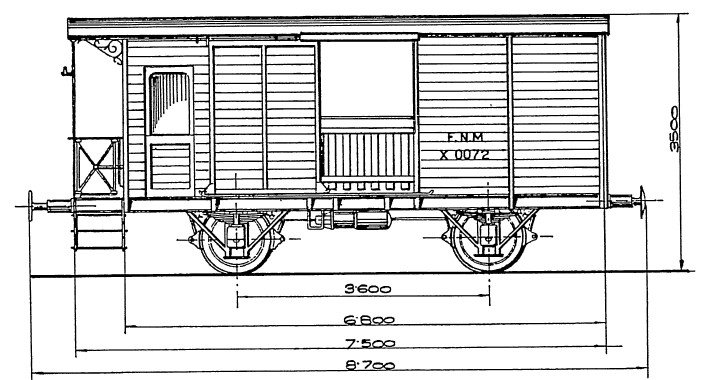To complete the collection of vehicles representing the origins of Ferrovie Nord, the creators of the historic train rightly decided to include a freight wagon in the composition. They chose the X 0072 wagon, to represent the closed wagons of which numerous series and types existed at FNM. The wagons in this series were built in 1916 by Carminati & Toselli in Milan, and were modified in the 1950s-1960s to convert them into weighted coaches for the conductor and staff accompanying the goods trains which were still common until the early 1970s. The wagon was fitted with benches inside for an overall seated capacity of 19. In addition to being standard goods wagons, they also featured interconnecting gangways to allow movement between coaches. The interiors were adapted by polishing the wooden boards of the inner walls, and by retaining the electric lighting and the two large doors for loading and unloading goods, which were suitably protected by wooden barriers.
X-0072

- Progettazione: 1916
- Costruzione: 1916
- Esercizio: 1916-presente
- Massa in servizio: t.12
- Ruote Ø: 1.060 mm
- Costruttore: Carminati e Toselli
- Lunghezza fuori tutto: 8.700 mm
- Passo rigido: 3.600 mm
- Velocita massima: 70 Km/h
- Illuminazione: elettrica
- Altezza imperiale: 3.500 mm
- Posti a sedere: 19 posti
- Freno: Continuo
- Portata: t. 3
- Livrea: grigio
- Design date: 1916
- Build date: 1916
- Service date: 1916-present
- Service mass: 12 tons
- Wheel Ø: 1,060 mm
- Builder: Carminati and Toselli
- Overall length: 8,700 mm
- Rigid wheelbase: 3,600 mm
- Maximum speed: 70 Km/h
- Lighting: electric
- Roof height: 3,500 mm
- Passenger capacity: 19 seats
- Braking system: Continuous
- Load capacity: 3 tons
- Livery: grey
The interior is typical of a late 1800s/early 1900s carriage. Small in size, like most FNM carriages, it has a wooden plank floor, sliding doors, liftable barriers for staff safety and a small space for the conductor. During the changes of the post-war years these wagons were fitted with a small platform at one end to allow staff to board, a window on each side, and, in some wagons, a platform and gates to access the locomotive. The wagons in this series were weighted to increase braking effectiveness by installing sand-filled boxes at the wheels. As many old FNM goods trains were not fitted with automatic braking systems, this vehicle was also used to improve the braking of short FNM goods trains. Lighting was provided by electric ceiling lights. During restoration, the wagon retained its service number, while benches were created above the ballast boxes to seat around 19.

